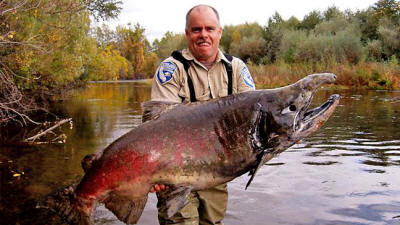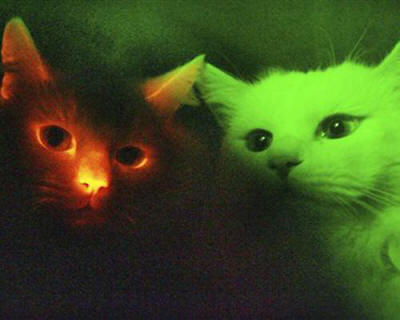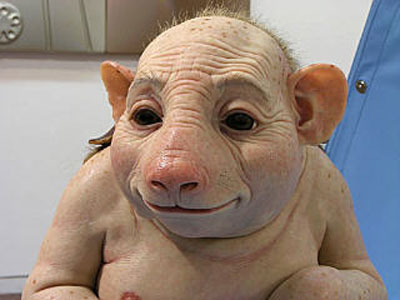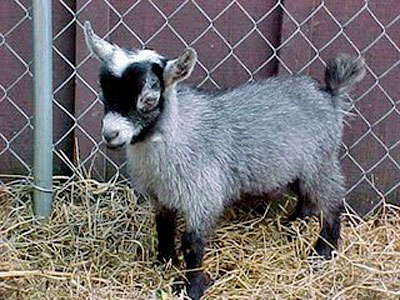|

June 27, 2011
from
EndOfTheAmericanDream Website
Spanish version
Did you know that today scientists are actually producing mice that
tweet like birds, cats that glow in the dark, "monster salmon",
"spider goats", cow/human hybrids, pig/human hybrids and even
mouse/human hybrids?
The very
definition of life on earth is
changing right before our eyes.
Many scientists believe that genetic
modification holds the key to feeding the entire planet and healing
all of our diseases, but others are warning that genetic
modification could literally transform our environment into a
desolate wasteland and cause our world to resemble a really bad
science fiction movie.
For decades, scientists around the globe have
been fooling around with DNA and have been transplanting genes from
one species to another. But now technology has advanced so
dramatically that just about the only thing limiting scientists are
their imaginations.
The things you are about to read about below are truly bizarre. In
recent years, science has really "pushed the envelope" and
scientists all over the planet are quite eager to push it even
farther.
But is genetic modification really safe? Just because we have
discovered that we can do something does that mean that we should
rush forward and do it?
Recent films such as "Splice" (below video) have highlighted some of the potential
dangers of genetic modification, but most scientists don't see any
reason to be concerned.
In fact, in most countries scientists seem very eager to push
regulators to allow them to go farther and farther. In quite a few
countries there are very few boundaries left.
This is a point that I made in an article I authored for another
blog called
The Future...
At this point there are very few restrictions remaining on fields
such as nanotechnology, biotechnology, synthetic biology, cloning
and genetic modification.
All over the world, scientists are
feverishly combining different kinds of animals together, adding
plant genes to certain animals, and even putting human DNA into
plants and animals. Life as we know it is literally changing, and it
is very hard to tell what the future is going to look like if all of
this continues.
Sadly, most people have no idea what is going on out there.
Most
people believe that scientists only have our best interests at heart
and that they would never do anything "weird" or "dangerous".
Well, read the following examples of genetic modification below and
decide for yourself whether or not things have gotten out of
control.
The following are 10 signs that our world may be destined to
resemble a really bad science fiction movie....
-
In China, scientists have inserted human genes into the DNA of
dairy cow embryos.
At this point, approximately 200 hybrid cows have
been successfully produced. These cows can produce milk that is
virtually
identical to human breast milk.
The scientists hope to
have huge herds of these cows producing an alternative to human
breast milk soon, and they hope to have this "milk" sold in global
supermarkets
within 3 years.
-
In Canada, scientists at the University of Guelph in the province
of Ontario have produced what they are calling "enviropigs".
These "enviropigs"
have had genes from mice spliced into them, and according to the
scientists they produce less phosphorous in their poop so they are
being touted as environmentally friendly.
Authorities in both the
U.S. and Canada are evaluating whether or not to allow these "enviropigs"
into the food supply.
-
Scientists in Japan have created a genetically modified
mouse
that tweets like a bird.
-
One U.S. corporation can now produce a very muscular "monster
salmon" which can grow up to three times as fast as normal salmon
do.

-
Science can now produce
cats that glow in the dark.
A genetically
modified cat created by scientists named Mr. Green Genes was the
very first fluorescent cat in the United States. But Mr. Green Genes
was not the first "glow in the dark cat" in the world.
That honor
went to a cat created by a team of scientists in South Korea.

-
In Japan, scientists have discovered that they can grow rat
organs inside of mice. The researchers hope to use the same
technology to
grow human organs inside of pigs.
-
But Japan is not the only one doing this kind of research. In
Missouri, entities that are
part pig and part human are being grown
with the goal of providing organs for human transplants.

-
Scientists at Rockefeller University have injected human genes
into mice. These "humanized mice" are being used to study the spread
of the hepatitis C virus.
-
U.S. scientists have discovered
that they can actually "grow" new human organs from scratch.
The following is a quote from a
recent Newsweek article...
-
It might sound like science fiction, but growing new organs from
scratch has already become reality. In addition to bladders,
scientists have engineered new skin, bone, cartilage, corneas,
windpipes, arteries, and urethras.
-
Believe it or not, a company in Canada known as Nexia has
actually taken goats and has genetically modified them to be part
spider.
The genetic modification process causes these "spider goats"
to produce spider silk protein in their milk. This spider silk
protein is collected, purified and spun into incredibly strong
fibers.
These fibers are apparently more durable than Kevlar, more
flexible than nylon, and much stronger than steel.

As frightening as all of those examples may sound, the truth is that
the genetic modification of plants has gone even farther than the
genetic modification of animals has gone.
Today, approximately 93 percent of all soybeans and approximately 80
percent of all corn in the United States
have been genetically
modified.
Considering the fact that corn is literally in thousands upon
thousands of our food products, there is a really good chance that
you consumed some genetically modified food today.
Are you certain that it was safe?
Genetically modified crops have been linked to organ disruption in
at least
19 different studies.
In addition, there is also an increasing body of evidence that
suggests that genetically modified food actually
alters our
digestive systems.
Do we really know everything that we need to know about genetically
modified food?
Perhaps we should have investigated all of this sooner. The truth is
that once genetically modified crops get out into the wild it is
just about impossible to put the genie back into the bottle.
A while back, a genetically modified strain of maize that was banned
in the EU was accidentally
sown all across Germany.
Oops...
But once it got out there was no way of totally eliminating it. In
fact, in many areas of the world genetically modified crop strains
are breeding natural crop strains out of existence.
We are permanently changing the natural order of things.
Is that really a great idea?
Sadly, things are only going to become much more bizarre in future
years.
DARPA's current budget actually includes money that is allocated for
the development of this kind of technology. Apparently the goal is
to someday produce "super soldiers" with "edited DNA" and
implantable microchips.
In this article I have only talked about the stuff that we know
about and that is admitted in the mainstream media.
So what is going on out there that we don't know about and that the
mainstream media is not admitting?
In past decades, genetic engineering was extremely expensive and it
was only done by top scientists.
Today, even
college students are transplanting genes and creating
new life-forms. There seems to no longer be any taboo on monkeying
around with the fabric of life.
The field of "synthetic biology" is
extremely hot right now and very small companies are "creating" new
plants, new animals and even new microorganisms in garages and
basements all over the globe.
-
So what will the future bring?
-
Will genetic modification enable us to feed the entire world and
will it enable us to heal all of the horrible diseases which afflict
us?
-
Or will genetic modification result in a nightmarish world where
"man-made life" and twisted human-animal hybrid creatures are free
to roam and breed?
-
Will our bizarre experimentation destroy the environment and turn
this planet into a bizarre wasteland?
Only time will tell...
La Modificación Genética Fuera de Control
Junio 29, 2011
del Sitio Web
TrinityATierra
traducción parcial de Trinity a Tierra
Versión original
¿Sabías que hoy los científicos están produciendo ratones que pían
como pájaros, gatos que brillan en la oscuridad, “salmones- monstruo”,
híbridos de vaca/hombre, híbridos de cerdo/hombre e incluso híbridos
de ratón/humano?
La misma
definición de vida sobre la Tierra está cambiando justo
delante de nuestros ojos.
Muchos científicos creen que la modificación genética tiene la llave
para alimentar al planeta entero y curar todas las enfermedades,
pero otros están alertando de que la modificación genética podría
literalmente transformar nuestro medioambiente y convertirlo en una
tierra desolada y causar que nuestro mundo recuerde a una película
de ficción de serie B.
Durante décadas, los científicos en todo el mundo han estado dándole
vueltas al ADN y han estado trasplantando genes de unas especies a
otras.
Pero ahora la tecnología ha avanzado tan dramáticamente que lo único
que limita ya a los científicos es su imaginación.
Lo que vas a leer puede sonar un poco raro. Los últimos años, la
ciencia ha abierto “la caja de Pandora” y científicos en todo el
planeta están deseosos de abrirla aun más.
¿Pero es la modificación genética algo seguro? ¿Sólo porque hemos
descubierto que podemos hacer algo, significa que tengamos que
correr a hacerlo?
Películas recientes como “Splice” (video abajo) han subrayado alguno de los
peligros potenciales de la modificación genética, pero la mayor
parte de los científicos no ven razones de peso para estar
preocupados.
De hecho, en la mayor parte de países los científicos parecen muy
ansiosos de presionar a los reguladores para permitirles ir más y
más allá. En algunos países hay pocos límites y barreras que se lo
impidan.
Este es un punto que demostré en un artículo llamado “El futuro…”
En este asunto hay muy pocas restricciones que queden en campos
tales como nanotecnología, biotecnología, biología sintética,
clonación y modificación genética.
En todo el mundo, los científicos
están combinando con fervor diferentes clases de animales, añadiendo
genes de vegetales a ciertos animales e incluso poniendo ADN humano
en animales y plantas. La vida como la que conocemos está
literalmente cambiando, y es muy duro predecir qué futuro nos espera
si esto continúa.
Tristemente, la mayor parte de la gente no tiene idea de lo que
ocurre. La mayor parte de la gente cree que los científicos actúan
sólo en el mejor interés común en sus corazones y que nunca harían
nada “raro” o “peligroso”.
Bueno, lee los ejemplos siguientes de modificación genética más
abajo y decide por tí mismo si las cosas se han ido o no del control
de nuestras manos.
-
En China, los científicos han insertado genes humanos en ADN de
embriones de vaca.
En este mundo, hasta la fecha, aproximadamente,
200 vacas híbridas han sido producidas exitosamente. Estas vacas
pueden producir leche que es virtualmente
idéntica a la del pecho de
hembra humana.
Los científicos esperan tener grandes rebaños de
vacas produciendo una leche alternativa a la de la hembra humana muy
pronto, y esperan vender esta “leche” en los supermercados de todo
el mundo
en 3 años.
-
En Canadá, los científicos de la Universidad de Guelph en la
provincia de Ontario han producido lo que llaman “cerdos verdes” .
Estos cerdos tienen genes de ratón y según los científicos producen
menos fósforo en sus excrementos, así que son mucho más amistosos
con el medioambiente.
Las autoridades en Canadá y Estados Unidos
están evaluando si deben permitir a estos “cerdos verdes” entrar en
la cadena de suministro.
-
Los científicos en
Japón han creado un
ratón genéticamente
modificado que pían como un pájaro.
-
Una corporación de USA pueden ahora producir un
salmón-monstruo
musculoso que puede crecer hasta 3 veces más que uno normal

-
La Ciencia puede ahora producir
gatos que brillan en la
oscuridad.
Un gato genéticamente modificado creado por un científico
con el nombre de Sr. Green Genes (Sr. Genes Verdes) fue el primer
gato fluorescente en los Estados Unidos. Pero el Sr. Green Genes no
era el primer productor de gatos brillantes en el mundo.
Ese honor
fue a un gato creado por un equipo de Corea del Sur.

-
En Japón, los científicos han descubierto que pueden hacer crecer
órganos de rata dentro de un ratón. Los investigadores esperan usar
la misma tecnología para
crecer órganos humanos dentro de cerdos.
-
Pero Japón no sólo está haciendo este tipo de investigación.
En
Missouri, entidades que son
en parte cerdo y en parte humanos están
siendo creados con el objetivo de servir de bancos de órganos vivos
para transplantes humanos
¿algo así podría salir de estos experimentos?

-
Científicos en la Universidad de Rockefeller han inyectado genes
humanos a los ratones. Estos “ratones humanizados” están siendo
usados para estudiar la difusión del virus de la hepatitis C.
-
Los científicos de USA han descubierto que pueden “producir”
nuevos órganos humanos. La siguiente es una declaración literal de
un
artículo reciente de Newsweek:
-
“Puede sonar a ciencia ficción pero crecer nuevos órganos de cero ya
se ha convertido en realidad. Además de vesículas biliares, los
científicos han realizado mediante ingeniería nueva piel, huesos,
cartílagos, córneas, arterias y uretras”
-
Lo crean o no, una compañía de Canadá conocida como Nexia ha
modificado genéticamente a las cabras para que combinen con las
arañas.
El proceso de modificación genética da como resultado estas
“cabras araña” que producen proteína de seda de araña en su leche.
La proteína de seda de araña es recogida, purificada y convertida en
fibras increíblemente fuertes.
Estas fibras son aparentemente más
duraderas que Kevlar, más flexibles que el nylon y mas fuertes que
el acero.

Tan terrorífico como estos ejemplos puedan sonar, la verdad es que
la modificación genética de plantas se ha ido incluso más lejos que
la modificación genética de animales.
Hoy en día, aproximadamente el 93 por cierto de todas las habas de
soja y aproximadamente el 80 por ciento de todo el maíz de los
Estados Unidos está genéticamente modificado.
Considerando el hecho de que el maíz está literalmente en miles y
miles de productos de los supermercados, es muy posible que estés
consumiendo alimentos genéticamente modificados ahora mismo.
¿Estás seguro de que esto es seguro?
|




